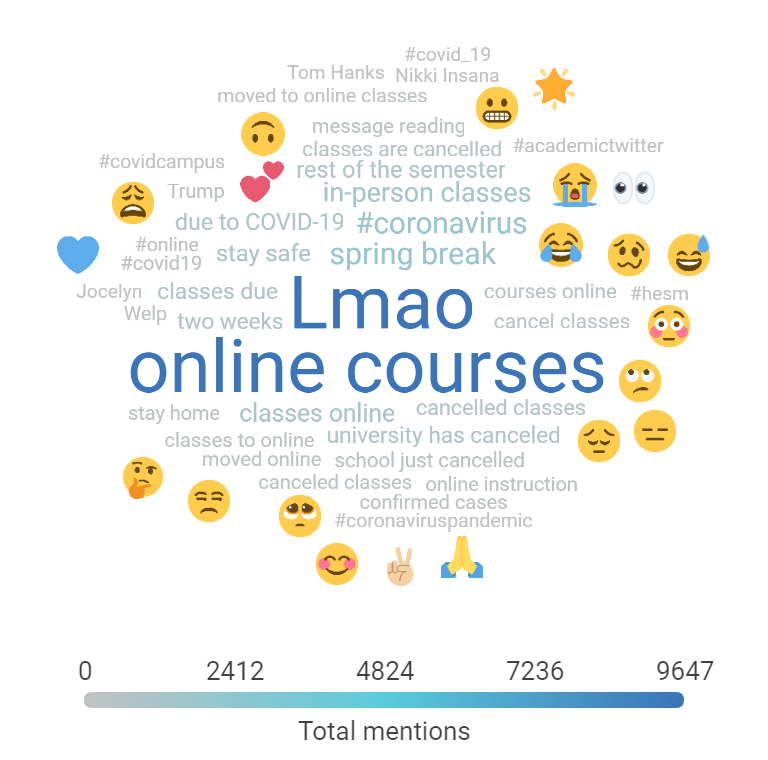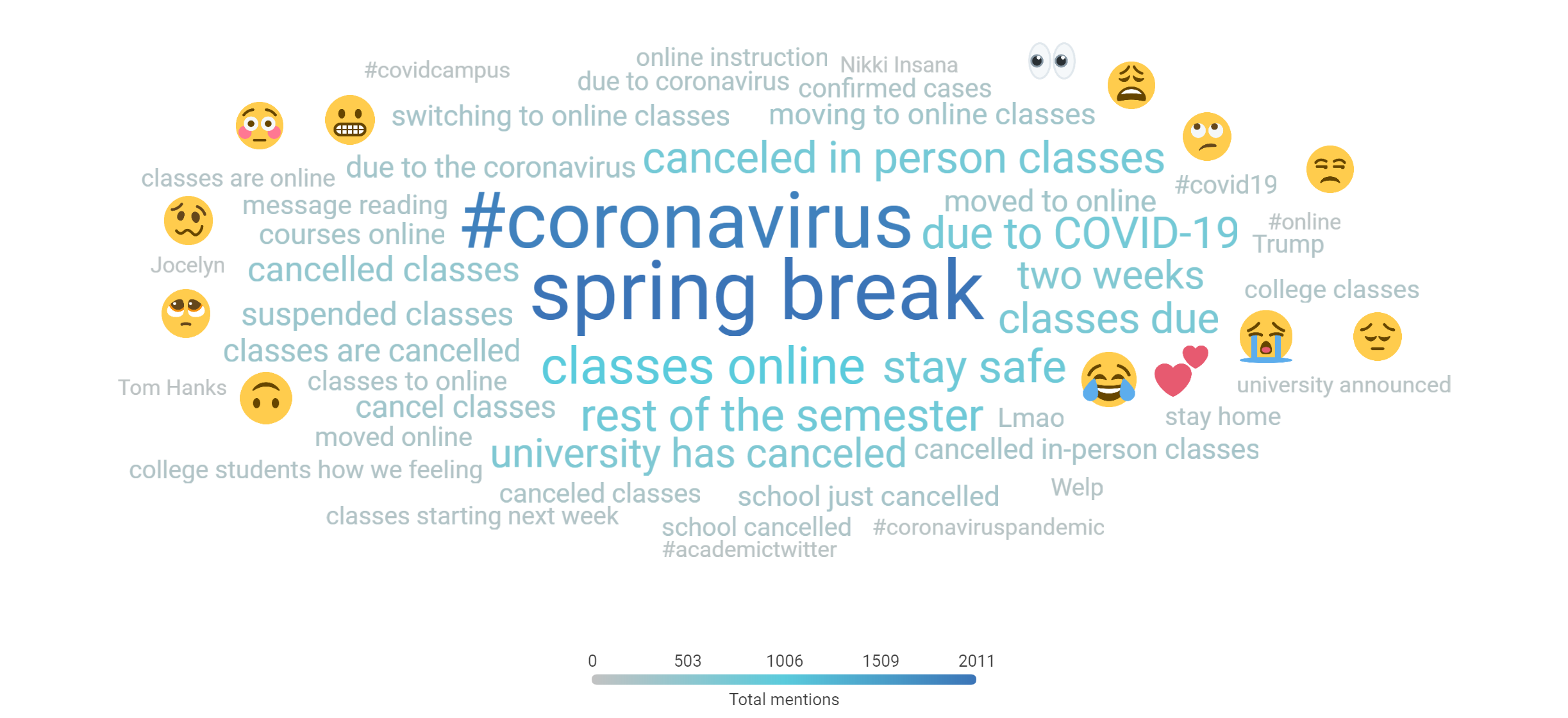Coronavirus Higher Education Industry Briefing: March 13

March Madness May Be Gone, But Meme Madness Is Here
We’re back with an updated analysis of online conversation about coronavirus and higher education, with data from Wednesday and Thursday, March 11–12. Starting next week, we’ll publish the Coronavirus Higher Education Industry Briefing on Tuesday and Friday afternoons. As we’ve done this week, each Briefing will include a report in a blog post and a slide deck. (Pro tip: I write the report as if I’m narrating the data in the slide deck; feel free to use it to build your speaker notes if you present it to campus colleagues.).
If you’d like to receive it in your inbox as soon as we publish it, sign up at info.campussonar.com/covid19. You can also review all prior Briefings. Because of the changing nature of social media data and our understanding of the conversation, each briefing covers a distinct point in time. Comparisons from briefing to briefing may be helpful, but we can’t draw correlations like we could if we were using other datasets such as surveys or historical social media data.
Higher Ed Stays in the Coronavirus Spotlight
Online conversation continued to increase, doubling from Tuesday to Wednesday and increasing by 30 percent on Thursday. The conversation over this two-day period increased significantly compared to the prior two days. Additionally, more people contributed to the conversation (600,000+) indicating widespread public interest.

We categorize conversation for this analysis in two ways.
All Mentions Captures every online mention that includes terms related to coronavirus AND the higher education industry. Higher ed may be just a small part of the mention (e.g., a news story discussing the impact of the coronavirus in a metro area with a mention of campuses that closed).
Higher Ed-Focused Mentions is a subset of All Mentions. It captures when a campus or the industry is the focus of a mention about coronavirus (i.e., a headline of a news article or in a social media post).
Higher education remains in the spotlight (an emerging trend we noticed in our first Briefing). It’s still true that more than half of our data set isn’t higher ed-focused, such as when the industry is mentioned along with other activities affected by the coronavirus (e.g., NBA, MLB), but the share of conversation that’s higher ed-focused is increasing. On Thursday, higher ed-focused conversation was 41 percent of all mentions, compared to 38 percent on Monday.
News Sites Are Dwarfed by Social Media Conversation
Social media continues to dominate as a source of conversation.
Although over 30,000 coronavirus-related news articles mentioned higher education, news represents only 4 percent of the total conversation volume. Furthermore, only 16 percent of those articles focused on the higher education industry.
When higher education was the focus of coronavirus conversation, 91 percent of the time it was on social media, compared to 7 percent on forums and less than 2 percent on news sites.
Use Hashtags to Aid Messaging and Campus Social Listening
Hashtags are relevant because social media is so dominant in the conversation. When publishing social media updates or searching for campus-related coronavirus conversation, it’s important to know what hashtags are being used. When discussing higher education and the coronavirus, the top hashtag is #coronavirus, followed by #covid19. Less frequent, but still common hashtags include #covid_19, #CoronavirusPandemic, and #breaking.
 How Do We Cope? Memes
How Do We Cope? Memes
The top phrases and emojis for the higher ed focused coronavirus conversation aren’t surprising, until you look at the second-tier terms. You may wonder why the University of Phoenix is trending, since it already uses distance learning. Or perhaps Puerto Rico, which we haven’t heard much about in relation to the coronavirus. The answer? Memes. Students are using memes to express their feelings and cope with an uncertain situation.

The University of Phoenix shows up because of this meme on Twitter, which repurposes a January statement from rapper Soulja Boy accusing Drake of ripping him off along with the text “University of Phoenix watching all the colleges make their classes online.” As of Friday midday, the video had 2.9M views, and the tweet had 33,000 retweets and close to 150,000 likes. (Note: If you’re still working in an office and not wearing headphones, you may want to turn the volume down to avoid cursing out your colleagues.)
In addition to memes, there is some commentary related to student dissatisfaction with online courses, making comparisons to the University of Phoenix. The meme dominates this topic, though.
Puerto Rico is also the focus of a meme. It uses a popular TikTok effect and a cat (internet gold, really) to insinuate that students will take the opportunity to travel and party because they don’t need to be in class. It had 4.3M views as of Friday midday, with close to 300,000 likes and retweets.
Hidden Voices of Students and Family Members
When the conversation is this large it’s hard to find the individual voices. While over 280,000 individual accounts are contributing to conversation specifically about higher education and the coronavirus, only 8 percent of the mentions are first-person accounts from individuals who reveal an affiliation with a campus. These hidden voices represent lived experiences that provide valuable insight as you craft your communication and service delivery.
During the last two days, this conversation is mainly from students, with about 7 percent from family and friends. Students are sharing much more now than they were earlier this week. We identified five times more conversation from students in this analysis than our first briefing, in part because of the memes they’ve created about their experience (yes, we’re going to talk about memes again).
More Students Tweet, but Some Tumblr
The most common site for student coronavirus conversation is Twitter. Tumblr comes in second followed closely by Reddit. There’s only a smattering of conversation on other sites. Yes, we’re still seeing students post on Tumblr.
Please note that due to data access restrictions, we aren’t including Facebook, Instagram, Snapchat, TikTok, or LinkedIn in any of our analysis. Your campus social media manager is the best source of information regarding conversation on those networks. We’ve heard that some are seeing over 1,000 inbound messages per day.
TikTok, for example, is full of content from students such as a post from a University of Wisconsin student using the “can I get this?” meme. (If you need a 7-minute distraction, watch this YouTube compilation of TikToks to acquaint yourself with the meme). This week a sound was added to the app to the tune of “That’s Amore” with the lyrics, “When your class moves online and the boomers all die that’s corona. When the world steals your vibe and it comes for your life that’s corona.” Students using this sound are expressing anxiety and fear; one shares he’s deciding between going home and being unhappy or hurting his parent’s feelings by staying in the city where his college is located.
Memes Drive Student Conversation Topics
It’s not often that you see a topic cloud with “LMAO,” an internet acronym for laughing my ass off, front and center.

This is almost entirely because nearly 200,000 people interacted with a tweet from a Bluffton University student that says, “am i the only one that doesn't want my university to go to online courses??? i didn't sign up to take online courses for a reason... it's just going to make my life 10x more complicated lmao.” As it started to go viral and reach meme status, she clarified that she thinks it’s going to be much more difficult to understand the content in an online environment.
If you remove that tweet, the topic cloud is more like what one might expect.

The most common words and phrases like “spring break,” “classes online,” and “rest of the semester” are qualifiers for the news students are sharing along with their feelings. Look at the emojis, and you’ll see students are sad, confused, and suspicious.
Students and Parents Aren’t Feeling Great
For both students and parents, the combination of anger and sadness accounts for 70 percent of conversations that display emotions. Students are more likely to be angry than sad.
There is a bit of joy in the conversation from students and parents. It’s usually related to thanking people or companies for doing the right thing, or they’re using positive emojis like ❤️.
61 percent of mentions from students and parents discussing the coronavirus and higher education are negative. While perhaps not unexpected, this is astounding. We rarely see higher education conversations with prevailing negative sentiment.
In comparison, only 22 percent of the overall industry conversation about coronavirus is negative—still a significant portion, but more aligned with a generally unpleasant conversation. Students and parents are discussing this situation negatively nearly three times more than the general public.
Summary and Recommendations
Conversation about coronavirus and higher education continued to increase as the week wore on. While more campuses make announcements and adjustments to operations, more students and family members are talking about the issue. Negative sentiment prevails, and dominant emotions are anger and sadness. To cope, memes are becoming popular.
- Non-Stop Conversation: Student conversation is increasing, and this analysis doesn’t even consider many of the posts directed to your campus Facebook pages or groups, Instagram accounts, or any private messages. Determine what posts should be acknowledged or replied to. Triage. Make sure you’re getting updates from your social media manager about their workload, and provide them with opportunities to unplug and turn the accounts over to other staff members. Their workload is increasing every day.
- Memes: The memes are rising. Should you post memes from a campus account? Probably not yet. Let the students own the meme culture for now, but pay attention to it so you can ascertain their underlying emotions. There may come a time when memes help break the ice or build unity; we’re not there yet.
- Anger: Students are expressing a lot of anger, but it’s rooted in many different things. Don’t assume you know why students are angry if you haven’t been listening—both on social media and traditional communication channels.
- Listen for yourself: This Briefing is a 10,000 foot view of the conversation, and is likely missing nuances you would see on a campus level. Use our analysis as a guide to focus your attention on possible issues with your students, families, or campus community and plan for appropriate resources.
We Want to Know How You Use This
The Coronavirus Higher Education Industry Briefing is new territory for Campus Sonar. If you find it valuable, please let us know (tweet us at @CampusSonar, email info@campussonar.com, or comment on this post).
Do you have additional questions about the conversation you’d like us to consider for a future briefing? Let us know.

